Shopify vs Webflow: Which is suitable for your business?
Summer Nguyen | 07-01-2024
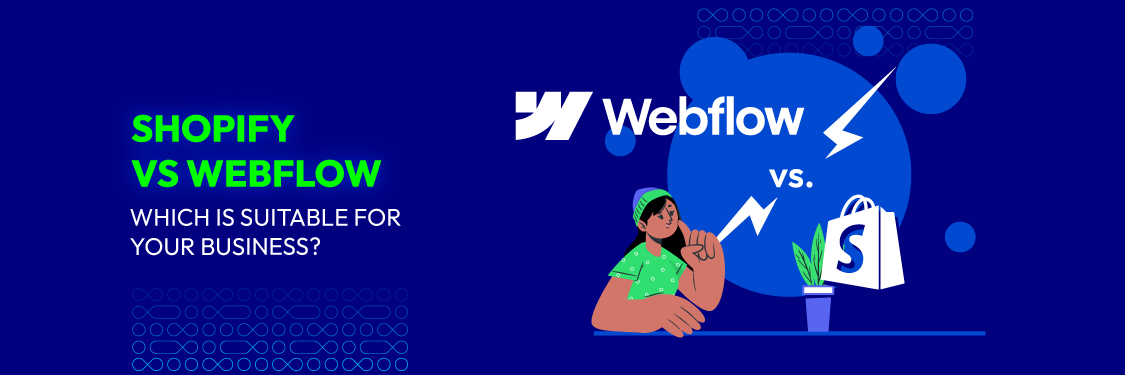
Businesses desire to own a professional online sales website and create a stable income. Many businesses want to develop an online store. They know it is the time for e-commerce.
In this article, we will introduce you to the uses of two platforms: Shopify vs Webflow. We will cover their features and their purposes. Are you curious about the differences between them? Let’s begin right now!
What is Shopify?
Tobias Lutke, Daniel Weinand, and Scott Lake founded Shopify in 2006. The main aim of Shopify is to help you run your stores and increase your sales and reach. Although you are not a skilled person in developing online stores, Shopify can still help you.
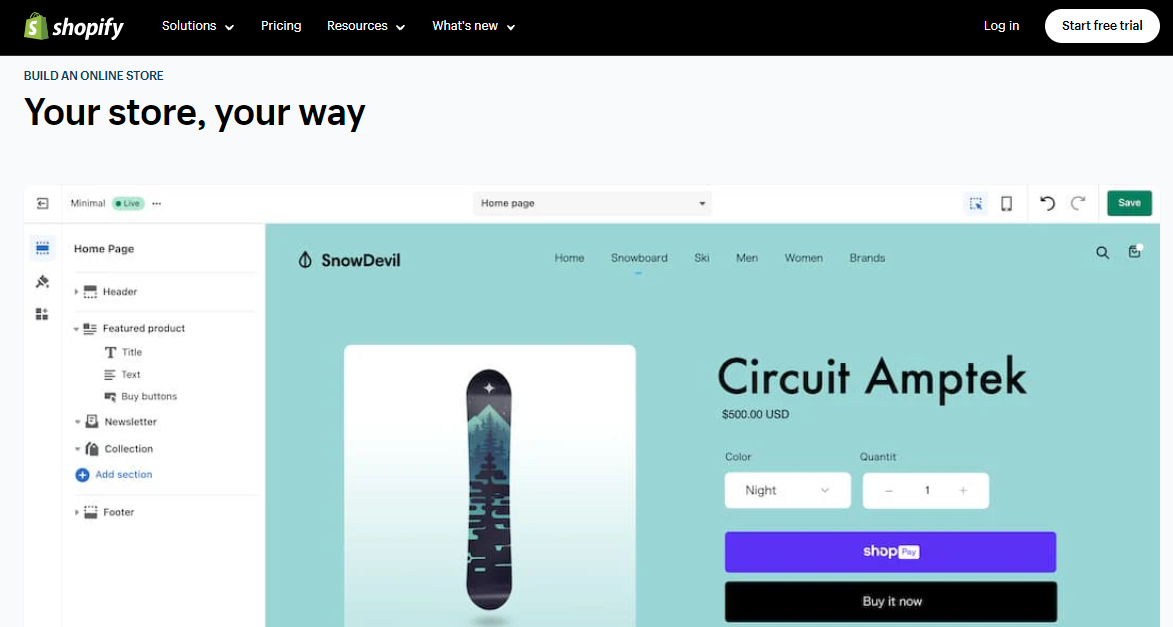
Of course, you have to pay to use Shopify, but It can be free for the first 14 days too. You can create your own website and freely customize it to sell and manage your products. Shopify has many tools. They can help you build an online store, design custom online experiences, and maximize your marketing ROI.
What is Webflow?
Webflow is just a design tool. It lets you design and build your store websites. You can also launch websites visually. You can use Webflow to start with an initial idea to end with a ready-to-use product. Webflow is the next-generation cloud-based CMS or web publishing system. Webflow is suitable for most websites, minimizes maintenance, and maximizes reliability.
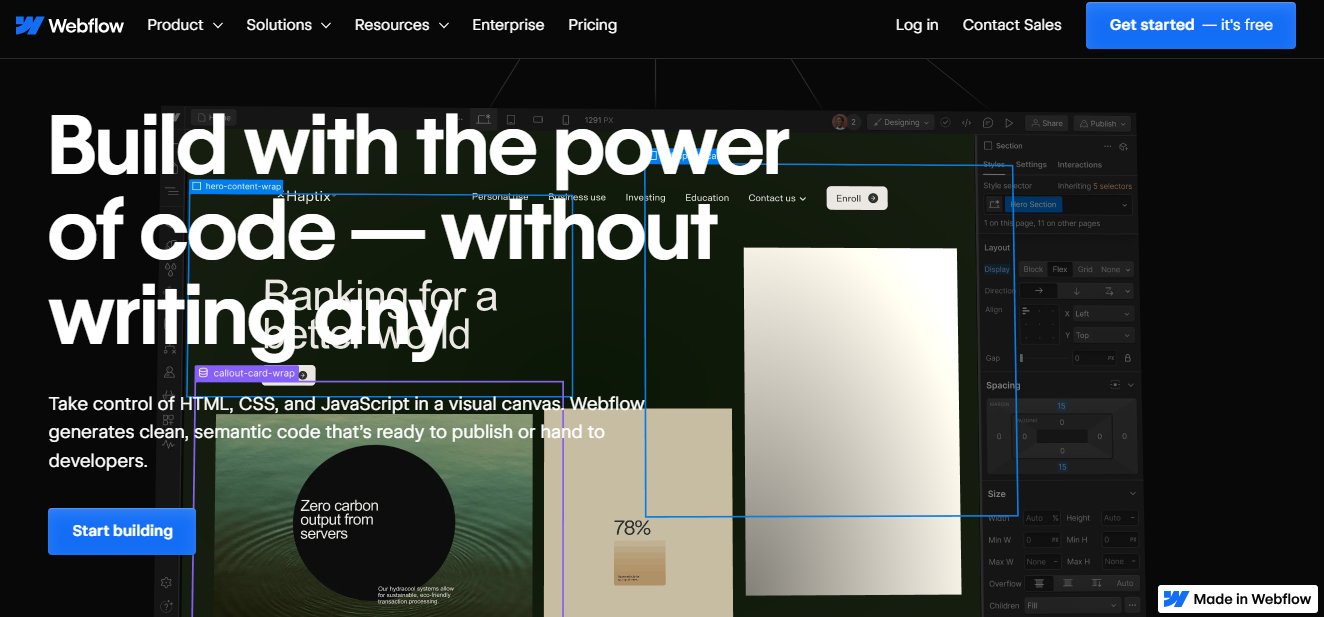
What is Webflow
Plus, if you have a custom domain, you can host your HTML sites on Webflow too! This makes it great for businesses. They want a top-quality website with tweakable features.
Shopify vs Webflow: Quick assessment
Shopify and Webflow are both platforms. They offer a selection of free and paid templates. These greatly simplify the web design process — and once again, no coding is required. However, the primary disparity between Shopify vs Webflow lies in their business approach:
- Shopify may be better for small or international businesses. Or for anyone who lacks coding knowledge. Or for anyone who just wants a good interface.
- Webflow may be better for web designers or developers. They want a robust place for their creations.
| Factor | Shopify | Webflow |
| Price List | Start at $19/month | Start at $18/month |
| Design Flexibility | Shopify templates are beautiful, no doubt. As long as you’re okay with your store looking just like your competitor’s. | Build custom sites, carts, and checkout experiences without template restrictions. |
| Ease of Use | Shopify’s more complex setup makes the actual running of your online store easier | Webflow is a powerful visual development tool with a learning curve. |
| E-commerce | Shopify is mainly for e-commerce. It offers some comprehensive features. | Webflow started as a general website. However, it became important to develop e-commerce. |
| SEO & Content | Shopify comes equipped with fundamental SEO features and content marketing for e-commerce businesses. | The strength of Webflow is its SEO optimization and content creation. |
| Scalability | Shopify can scale seamlessly as the business grows. | Webflow is better for small businesses. But, it may still need more development to scale your website. |
Shopify vs Webflow: The comprehensive comparison
1. Price List
Shopify
Shopify’s plans start at $9 per month. But, they quickly increase to $25 per month ($19 per month if paid yearly) for online store builders. But Shopify costs don’t end at its subscription price. You’ll also need a domain name. It costs $10 to $15 per year. You might also need a premium theme and plugins to maximize your store’s abilities.
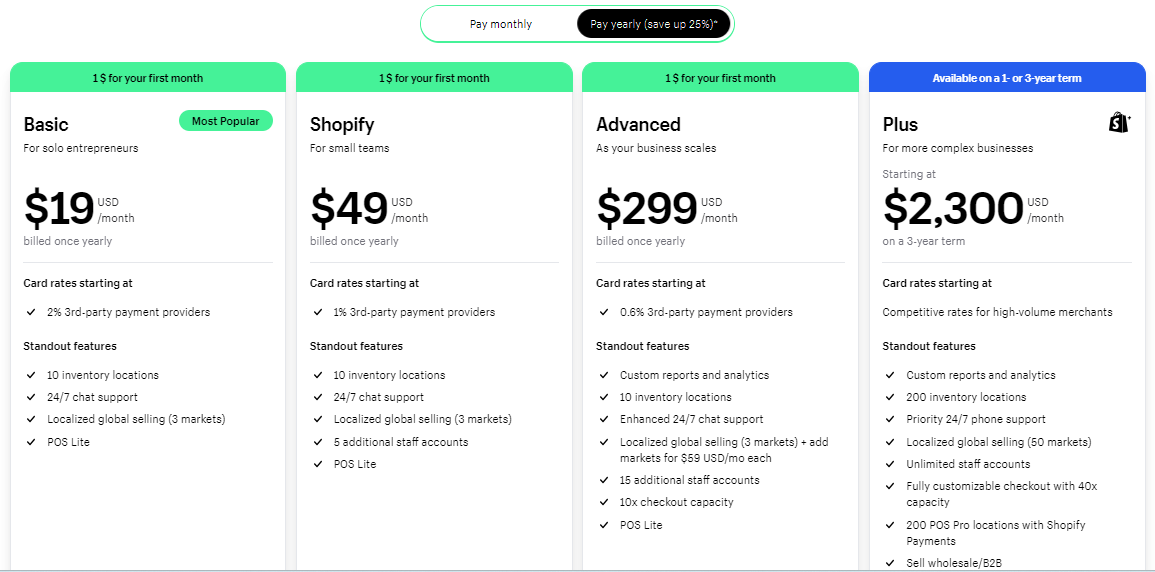
Prices for Shopify’s plans
Here is the overview of Shopify’s cost plans, and you’ll see there’s a big difference
Shopify Lite
- Monthly Cost: $9
- For those who want to add a buy button to their website. Or, for those who want to sell in person and need a point-of-sale (POS) processor.
- Transaction Fees: With online credit card rates of 2.9% + 30 cents, or just 2.7% for offline transactions
- Features: Order management, analytics and customer support
Shopify Basic
- Monthly Cost: $25 and $19 if paid annually
- Suitable for: Looking to build a comprehensive online store with omnichannel selling capabilities
- Transaction fees: With online credit card rates of 2.9% + 30 cents, or just 2.7% for offline transactions
- The software has many features. It has an online store, with both a website and a blog. It has solutions for businesses that want to offer in-store transactions, like card readers.
Shopify Standard
- Monthly Cost: $65 and $49 if paid annually
- Suitable for: Need to begin any international selling
- Transaction fees: 2.6% + 30¢ for online credit card rates or 2.5% + 0¢ for offline
- You will get everything in Basic, plus performance reports. You will also get up to five staff accounts and support for gift card purchases.
Shopify Advanced
- Monthly Cost: $399 and $299 if paid annually
- This is for businesses that sell large volumes both online and in person. They need more advanced features.
- Transaction fees: With online credit card rates of 2.4% + 30 cents, or just 2.4% for offline transactions
- Features: Adds on advanced reports, third-party shipping and international duties and import taxes
Shopify Plus
- Pricing: Custom pricing based on specific enterprise needs
- These solutions are for high-volume merchants. They have features like dedicated account management, customizable checkout, and advanced security.
In addition to the cost of Shopify plans, you often pay for a domain name ($15 per year) and premium theme ($75 – over $300 per year).
Webflow
Webflow’s price starts at $29 per month for Standard. It goes up to $212 per month for Advanced. And each plan will be suitable for each type of business. Here is the overview of Webflow plans that should take a look at:
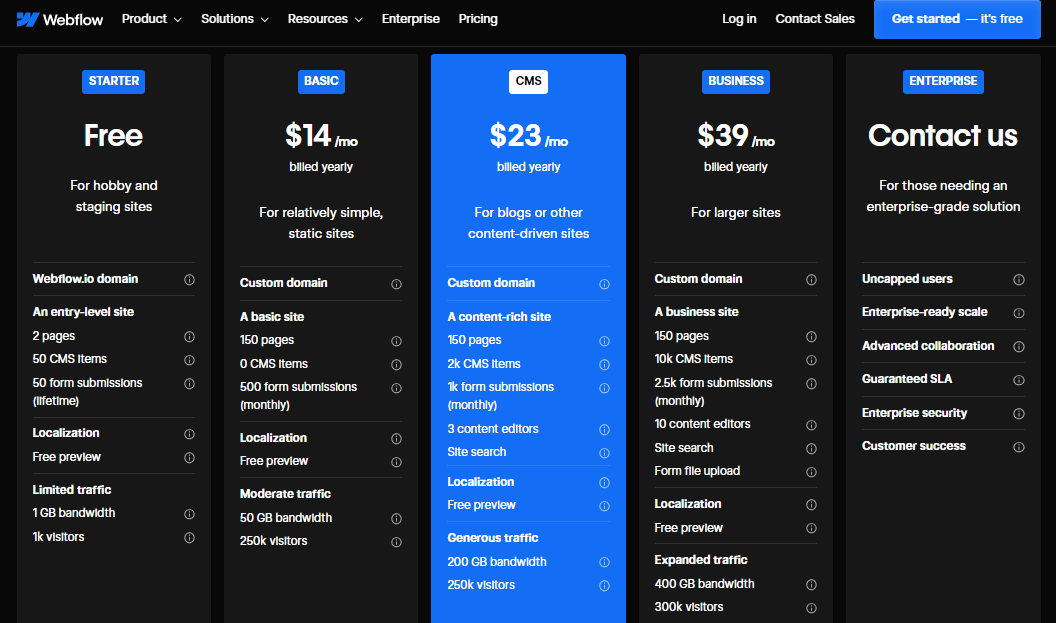
Webflow’s e-commerce plans
Standard
- Monthly Cost: $29 if billed annually
- Suitable for: If you have a new or small-scale online shop that generates up to $50k in annual sales
- You can get: 500 e-commerce items, 2000 CMS items, and all CMS plan features
- Transaction fee: 2%
Plus
- Monthly Cost: $74 if billed annually
- Suitable for: Your online store if it wants to generate between $50k and $200k in annual sales.
- You can get: 5000 e-commerce items, 10000 CMS items, and all business plan features
- Transaction fee: 0%
Advanced
- Monthly Cost: $212 if billed annually
- Suitable for: If your established online store is scaling beyond $200k in annual sales.
- You can get: 15000 e-commerce items, 10000 CMS items, and all business plan features
- Transaction fee: 0%
2. Design Flexibility
Shopify
Shopify offers nice themes and templates. They have customization options but come with some restrictions. Shopify provides customization options. But, it may not offer the design freedom of Webflow. Shopify gives you access to fewer templates. It has just 12 free ones and 165 paid ones. The paid ones range from $140 to $400.
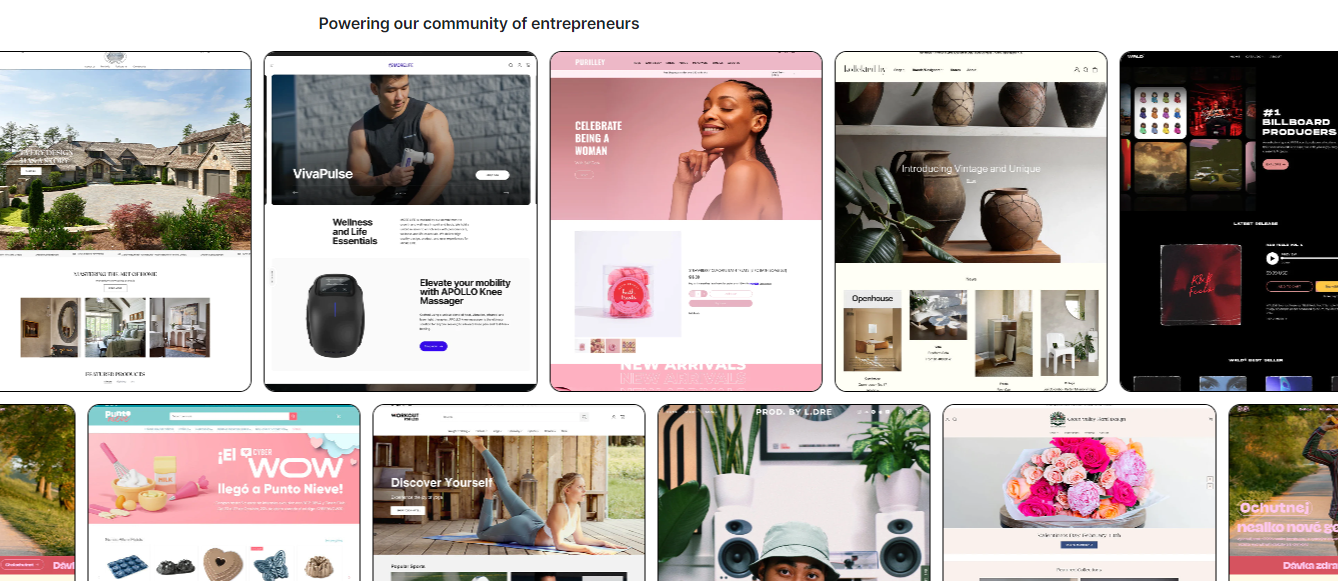
Shopify has 12 free templates and 165 paid-for ones
Users can choose from many templates and customize them a bit. But, the options for complex design and animations are much more limited than in Webflow. If the goal is to start quickly with low expertise using preset templates, then Shopify might be a better fit.
Webflow
Webflow provides complete design freedom. It empowers designers to create stunning and customizable online stores. Webflow gives you more templates than Shopify. It has over 2,000 templates. Shopify has around 200. Of these, 50 are free, and 1,900+ involve a one-off fee of between $29 and $129.

Webflow covers over 2,000 templates in total
It allows users to make custom websites. They get full control over the layout, animations, and interactions. This creative freedom is especially great for designers. They want to craft unique and visually engaging online experiences. If you prioritize design and creative freedom, Webflow is the clear winner.
3. Ease of Use
Shopify

Shopify includes various built-in templates and is relatively easy to use. As for Shopify, it’s like the cool, organized friend who always has your back. With its seamless onboarding and customizable templates, it’s smooth sailing for online stores.
Webflow
Webflow is known for its visual development tools. This is because its interface is so good. You can easily design your websites to match your ideas. It’s like having a magic wand for your creative visions.
4. E-commerce
Shopify
We have to say that Shopify is a real e-commerce platform. Its features are suited to the needs of businesses. It provides many tools to manage products and process payments. It also lets users analyze sales data and add more specialized features. That’s why I say this about e-commerce. Shopify stands out with its features. They are designed only for online selling.
Webflow
Webflow boasts features like customizable product pages, secure payment gateways, and inventory management. Webflow also offers strong e-commerce tools. But, some may need extra setup and customization. With Webflow, you can sell physical and digital goods, services included.
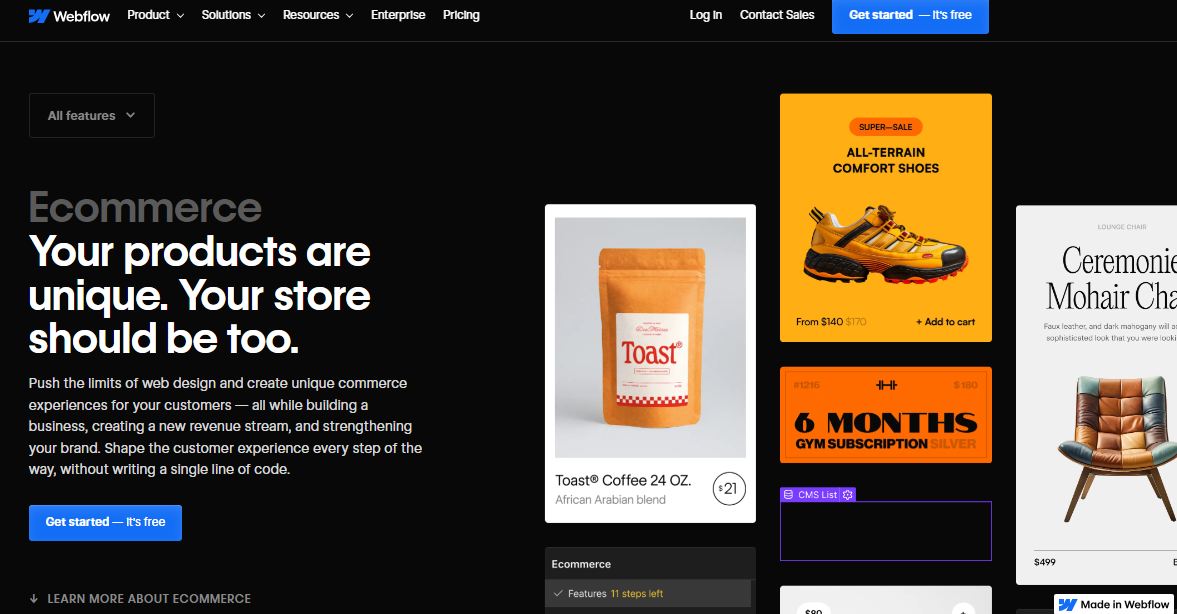
Your products are unique. Your store should be too
You can upload your products individually or group them into categories. On top of that, Webflow enables you to customize your delivery options. For instance, you can offer takeout. You can ship goods to customers’ doorsteps. You can send digital products via email, and more.
5. SEO & Content
Shopify
Shopify is great at e-commerce. It offers strong SEO and smoothly integrates with product-focused content marketing. Shopify is more design-centric than Webflow. But, it provides an easy solution for businesses. They combine online selling with content marketing efforts.
Its built-in blogging platform and product pages are optimized. They contribute to an effective content marketing strategy in e-commerce. If you focus on e-commerce with content marketing, Shopify offers a good solution. It is tailored to those needs.
Read more: 15 Important Strategies to Improve Shopify SEO for Your Store
Webflow
Webflow focuses on customizable on-page elements and clean code. This makes it a great choice for businesses. They prioritize a unique and good-looking online presence. Webflow integrates content creation with website design. It also supports multimedia. This positions it as a top choice for creative content marketers.
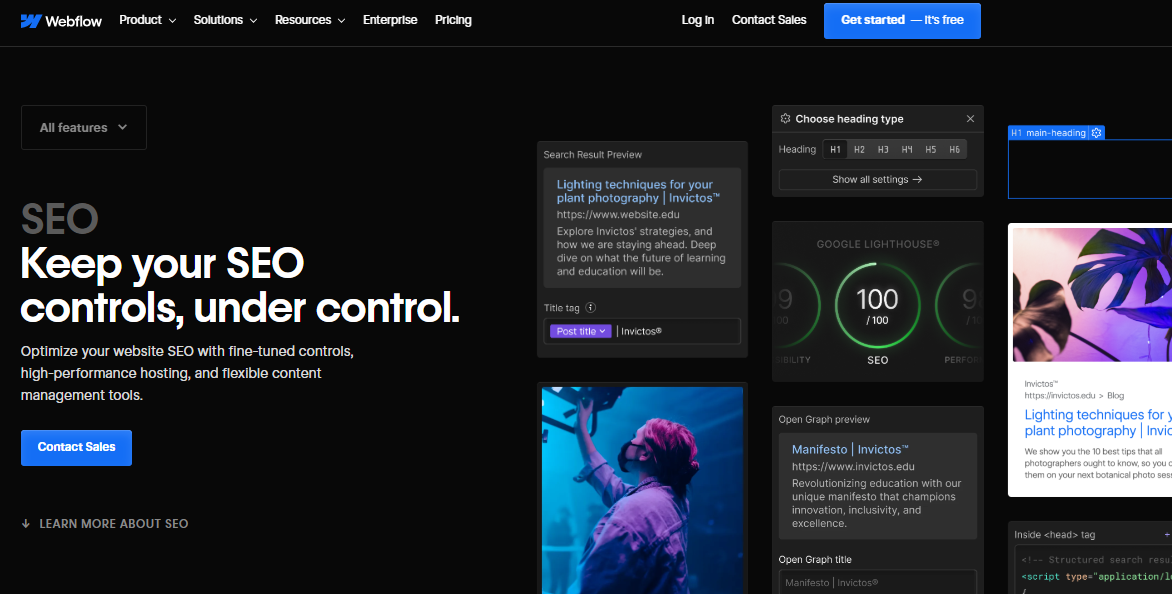
Keep your SEO controls under control.
If you need creative design and flexible content, Webflow may be the best. Webflow also has its own custom CMS (content management system). It stores your files.
6. Scalability
Shopify
Shopify is a heavyweight champion for other platforms. It is built to grow your business. If you are aiming for something perfect, choose Shopify. Shopify is also suitable for small start-ups or large companies. Its infrastructure aims to handle high levels of traffic and transactions.
Webflow
Webflow may be better for small businesses. But, it still needs extra development to scale your website. Webflow has made strides in improving its scalability. If your business is just starting or has moderate traffic, Webflow could do the trick.
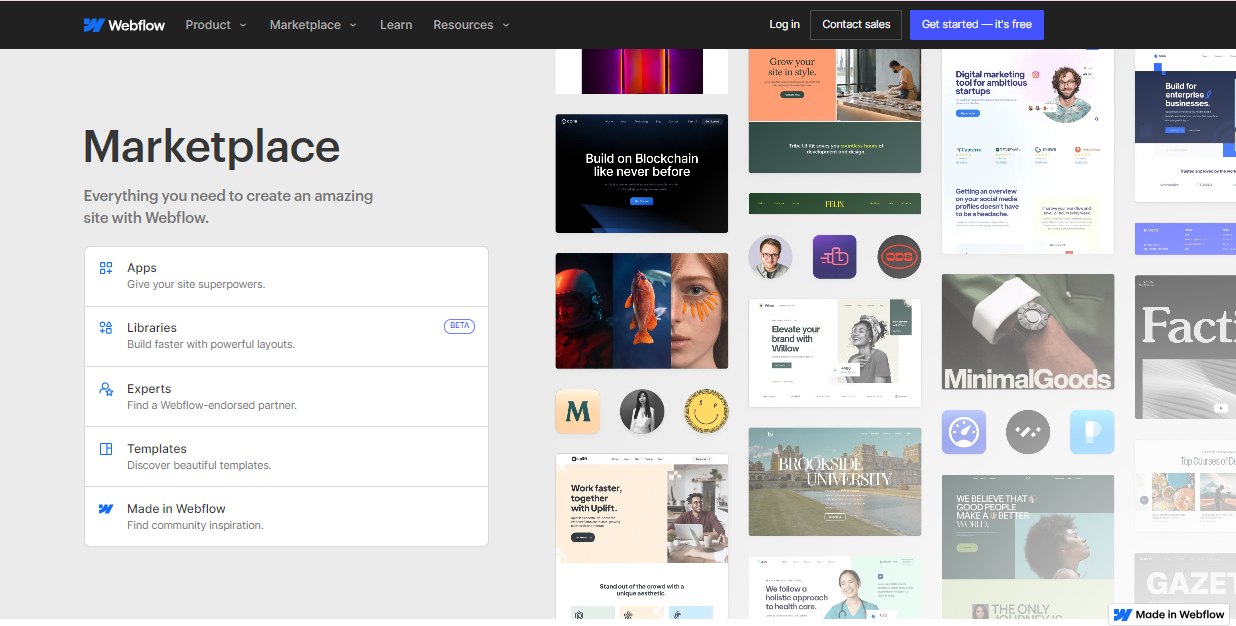
Everything you need to create an amazing site with Webflow.
Shopify vs Webflow: Which is the best for your business?
| Pros and cons | Shopify | Webflow |
| Pros | – Suitable for most customers, even those without much experience
– User-friendly interface, easy to use – Modern and diverse website interface – Using cloud storage technology – Can be combined with many other online sales channels such as Facebook, Instagram,… |
– The visual editor adds a great dimension to website building.
– Webflow provides fast hosting and a powerful editor that responds quickly. – No coding knowledge is needed. – Lots of online resources for users. – A free plan allows you to design your website to your heart’s content before you go live. |
| Cons | – Features serving businesses are not diverse, limited to large business
– The cost is higher than the average – The customer care system is sometimes overloaded – High transaction fees |
– Webflow doesn’t integrate with POS.
– Webflow’s support is limited to email and live chat. – Webflow’s user interface can seem intimidating to the uninitiated – Its pricing is confusing |
Considering the use of Shopify or Webflow, it is hard for your business to choose. You need to understand each platform’s strengths and weaknesses. They must fit your specific business. If you decide Shopify is the right choice, our Shopify Migration Service can help you make the switch smoothly and securely
Shopify is best for businesses that:
- Want to create a fully customizable online store with their own branding and domain name.
- Require advanced e-commerce features. These include inventory management, customer accounts, and multiple sales channels.
- Seek flexible payment options. Also, seek the ability to integrate with third-party apps and services.
- They want to grow their business. They have the money to invest in a better e-commerce platform.
Webflow is best for businesses that:
- Want to offer web design and development services and use a great visual builder
- Want to be an agency specializing in web design and development
- They are people and businesses. They want to offer their clients marketing, SEO, and content services.
Wrap up
Shopify may have an edge in ease of use and support. But, Webflow has made its mark and revolutionized how we design. It powers the No-Code movement. With its rich CMS and customization, Webflow might be better for most businesses. They need to stand out from their competition.
In the end, it depends on your business needs. Only you can decide which platform is better for your business.







